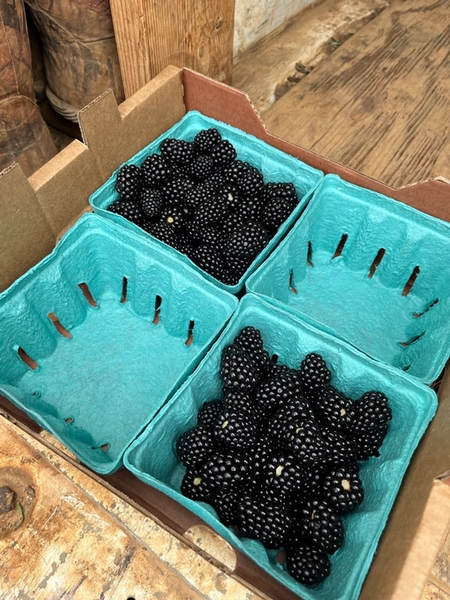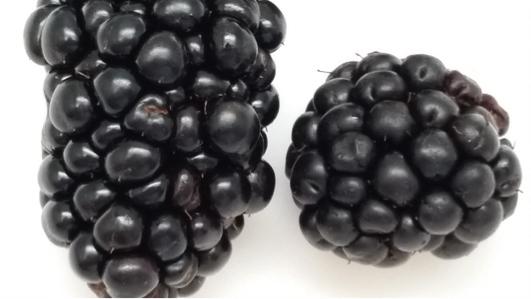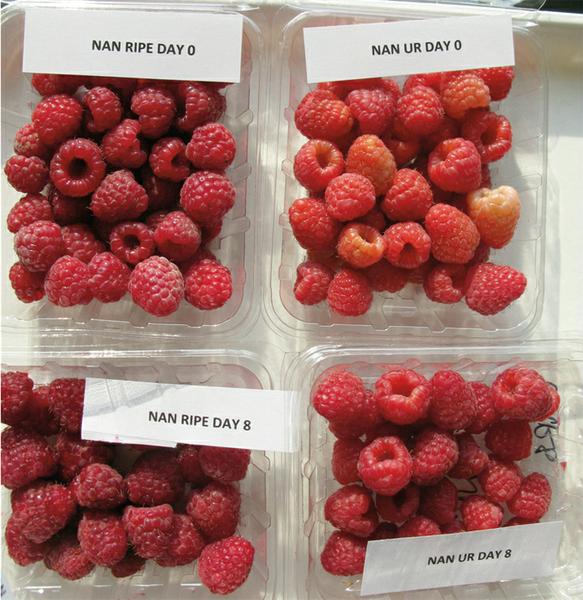General
The primary objective of postharvest handling of blackberries and raspberries is to maintain fruit quality. Follow the general guidelines below for harvesting blackberries and raspberries:
-
Select the correct number of pickers - approximately six to eight trained pickers are usually recommended per acre.
-
Use the correct basket. A variety of picking containers are available from your local distributor. Each one has its advantages and disadvantages. Decide which type of basket suits your individual needs:
-
Pulp baskets (Figure 13-1) are inexpensive, have ventilation holes for cooling, and can absorb water from fruit that is harvested wet. However, these baskets absorb juice on the bottom, which may be undesirable and require a cover if being shipped.
-
Commercial growers most commonly use clamshells (Figure 13-2). Clamshells are sturdy, plastic (PET - polyethylene terephthalate, the chemical name for polyester), vented boxes with hinged lids that allow boxes to be stacked without crushing the fruit. An absorbent pad is placed in the bottom of each clamshell to absorb excess juice and moisture from the fruit.
-
-
Pick fruit in the morning when the temperature is still cool, and the berries are firm.
-
Avoid picking in the rain or when the fruit is wet.
-
Use picking stands to prevent containers from contacting the ground.
-
Pick and handle the fruit carefully to avoid crushing or bruising.
-
Place harvested fruit directly into the picking container.
-
Use a separate container for culled fruit. Fruit culled for cosmetic reasons may be frozen or used in processing.
-
Gently place the berries no more than two to three berries deep in berry baskets or picking containers to avoid further bruising during storage. Half-pint containers are recommended for raspberries and pint containers for blackberries.
-
Cool the fruit as soon as possible after harvest. Coolers should be set at 33°F to 35°F with 90% to 95% relative humidity.
Blackberry
Harvest blackberries two to three times a week. For pick-your-own and local sales, it is better to pick when the color has a dull appearance to maximize flavor. At this stage, berries will have higher sugars but reduced shelf life, and are best suited for local markets. For shipping, pick blackberries when they are shiny black for acceptable flavor and longer shelf life (Figure 13-3).
Postharvest handling of blackberries is critical when selling fruit to retail or wholesale markets. Fruit reddening, also known as reversion or red drupe, can occur in stored blackberries. This reddening is characterized by one or several bright red drupelets that detract from the attractiveness of the berries. Although the exact cause is uncertain, possible causes include the cultivar, early harvest date, temperatures above 77°F during picking, immature fruit, chemical composition, and condensation on the fruit.
Raspberry
Harvest raspberries daily. Raspberry fruit are very soft and even more perishable than blackberries. Studies have shown that fruit can be harvested at the pink or light red stage for fresh market sale or at full redness for immediate sale at pick-your-own operations (Figure 13-4). Fruit that is picked unripe (yellow-pink) achieves full color, soluble solids content, acidity, and flavor (tasted at random) after six days of storage. Fruit that was picked pink is much firmer and less “leaky” than berries picked at the normal commercial fresh market ripe stage. However, research has found that fruit picked at this stage was 4% to 20% smaller, depending on the variety and relative ripeness at harvest. Growers must decide if extended shelf life or fruit size is more important.
Publication date: Feb. 23, 2023
AG-697
Other Publications in Southeast Regional Caneberry Production Guide
- Introduction
- Cultivars
- Site Selection
- Site Preparation, Planting, and Establishment
- Plant Growth
- Pruning and Training
- Trellis Systems
- Tunnel Production
- Water Management
- Integrated Pest Management and Pollination
- Fertility Management
- Fruit Development
- Harvesting and Postharvest Management
- Food Safety Considerations for Caneberry Production
N.C. Cooperative Extension prohibits discrimination and harassment regardless of age, color, disability, family and marital status, gender identity, national origin, political beliefs, race, religion, sex (including pregnancy), sexual orientation and veteran status.




